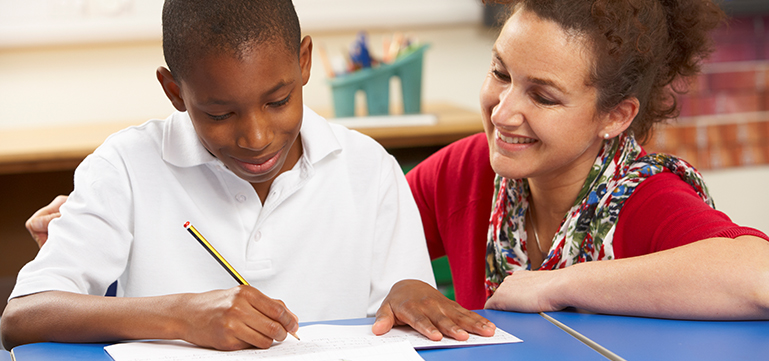Improving oracy skills using challenging texts

Information about the school
Tywyn Primary School is in Aberavon in the south east of Port Talbot in Neath Port Talbot local authority. There are 453 pupils on roll, including 84 part-time nursery pupils. There are 14 single-year classes and one mixed-year class. In addition, there are six learning resource classes, providing education for 48 pupils from across the local authority. This provision caters for pupils with moderate to severe learning needs and pupils with profound and multiple learning needs.
The average proportion of pupils eligible for free school meals over the last three years is 29%. This is well above the average for Wales of 19%. The school identifies 40% of pupils as having additional learning needs, which is much higher than the national average of 21%. This includes the pupils in the learning resource classes. A few pupils have a statement of special educational needs and a very few are in the care of the local authority. Most pupils are of white British ethnicity and come from homes where English is the main language. Very few pupils speak Welsh at home.
Context and background to the effective or innovative practice
Oracy was a school priority in 2016-2017 as a result of lower than expected pupil performance. Self-evaluation outcomes of scrutiny of planning suggested that opportunities for pupils to develop their oracy skills across the school were underdeveloped. Through internal moderation exercises there was a lack of oracy evidence to support teacher judgments in English. Predicted levels for pupils across the school strongly suggested that pupils were not on target to achieve the expected level at foundation phase and key stage 2.
The following actions were taken:
- Staff development training provided in speech and language therapy to identify groups for early intervention
- Audit and purchase of resources to develop the use of oracy/communication through ICT
- Staff audit – What opportunities were being provided for pupils to develop their oracy skills?
- Pupil voice – A questionnaire was completed to take account of pupils’ views and confidence in applying oracy skills
- Ensuring that planning provides opportunities for oracy, incuding clear progression for pupils
- Triad (groups of three teachers) lesson observation – with a clear focus on oracy and sharing of good practice
- Shared good practice across the cluster of schools using Hwb
- Listening to learners – the governing body interviewed pupils
- Developing opportunities for pupil voice in every class
- Criteria for effective talk for self/peer assessment was decided upon and opportunities to peer/self-assess across the curriculum were developed
- Re-introduction of class assemblies throughout the academic year, with attendance by parents and governors
- Set performance management targets through staff interviews to develop oracy
- Lesson observations and work scrutiny, with a focus on oracy
- Ensuring that opportunities to apply literacy across the curriculum are consistent
- Staff to attend termly advice clinics to ensure that strategies and approaches are appropriate and effective
- Tracking of pupils using assessment systems to ensure progression
- Children’s Literacy Development Officer to work with MAT focus group
Description of nature of strategy or activity
Pupils were required to:
- prepare talk to engage an audience, using appropriate vocabulary, expression, intonation and gesture
- use inference and deduction to show empathy with a character
Pupils read the poem ‘Timothy Winters’ by Charles Causley. This was analysed and pupils were encouraged to understand the characters and the underlying themes. Pupils were able to express their opinions by referring to and quoting directly from the text to support their views. Following from this, the pupils were encouraged to comment on how texts change when they are adapted for different media and audiences. This was achieved through analysing an animated version of the poem. These activities ensured that pupils were able to empathise and understand the poet’s ideas and language used. Once this was achieved, pupils created a success criteria for a ‘hotseating’ activity. The pupils were required to develop character awareness by taking on the role of a specific character and providing a witness statement. Pupils planned their talk, referring to the success criteria and quoting extracts from the poem to bring the character to life. This helped to develop inference and deduction skills and ensure quality and adventurous vocabulary choices. To ensure that high standards were achieved, MAT pupils led their own learning by modelling examples of high quality oracy performances, and set the required expectations to support and encourage all pupils to achieve a similar standard. Pupils were articulate and able to provide constructive criticism through effective peer and self‑assessment. This in turn led to all pupils progressing throughout the lesson, both individually and as a group.
What impact has this work had on provision and learners’ standards?
- There is a much greater emphasis on oracy activities across the whole school
- Pupils’ self-esteem has improved considerably and they are now more confident when performing for different audiences and for a variety of purposes
- Pupils are more articulate and able to use a wide range of vocabulary when speaking in a range of situations
- Pupils’ enjoyment of oracy activities has improved; activities are planned for, are pitched appropriately ensuring progression, and are purposeful
How have you shared your good practice?
Good Practice has been shared in the following ways:
- Triad Lesson Observations
- Cluster schools’ moderation
- School to school learning
- Governors – Listening to / questioning MAT pupils
Useful links
Other resources from this provider

Best practice in teaching and learning in the creative arts at key stage 2 - May 2015
pdf, 686.25 KB Added 01/05/2015